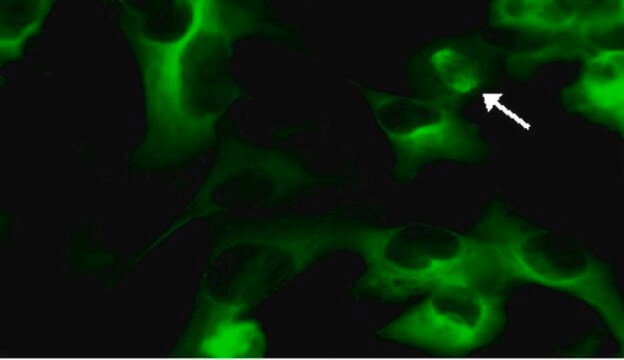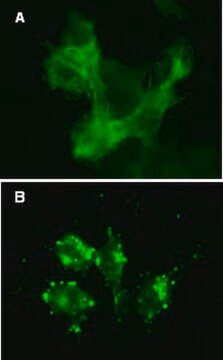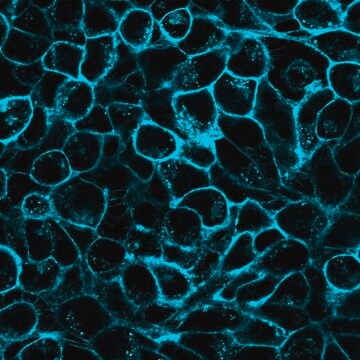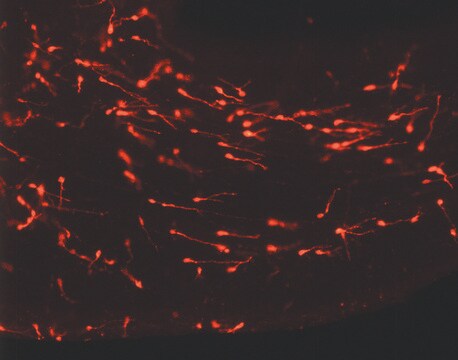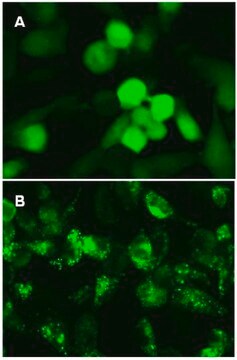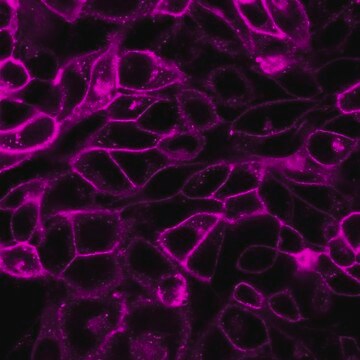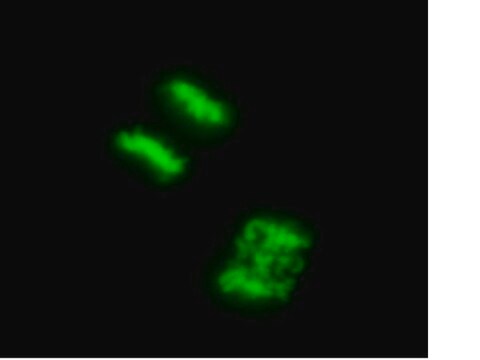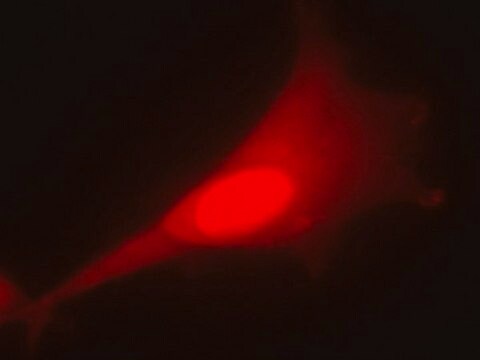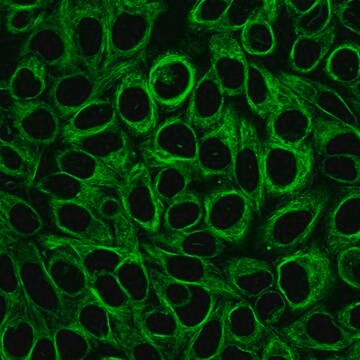17-10387
Biosensore lentivirale di controllo LentiBrite GFP
Sinonimo/i:
Lentiviral biosensor control particles
Autenticatiper visualizzare i prezzi riservati alla tua organizzazione & contrattuali
About This Item
Codice UNSPSC:
12352207
eCl@ss:
34360190
NACRES:
NA.51
Prodotti consigliati
Produttore/marchio commerciale
Chemicon®
LentiBrite
Livello qualitativo
tecniche
cell based assay: suitable
immunocytochemistry: suitable
immunofluorescence: suitable
transfection: suitable
Metodo di rivelazione
fluorometric
Condizioni di spedizione
dry ice
Descrizione generale
Potete leggere il nostro bollettino applicativo in Nature Methods!
http://www.nature.com/app_notes/nmeth/2012/121007/pdf/an8620.pdf
(Cliccare qui!)
Scoprite tutti i vantaggi dei nostri biosensori LentiBrite Lentiviral! Cliccare qui
I biosensori possono essere utilizzati per rilevare la presenza/assenza di una particolare proteina e la sua localizzazione subcellulare all'interno di una cellula allo stato vivo. I tag fluorescenti sono spesso auspicati come mezzo per visualizzare la proteina di interesse all'interno di una cellula mediante microscopia fluorescente o acquisizione video in time-lapse. La visualizzazione di cellule vive senza interruzioni consente ai ricercatori di osservare le condizioni cellulari in tempo reale.
I sistemi di vettori lentivirali sono uno strumento di ricerca diffusamente utilizzato per introdurre prodotti genici nelle cellule. La trasfezione lentivirale presenta vantaggi rispetto ai metodi non virali, come la trasfezione per via chimica, tra cui una maggiore efficienza di trasfezione di cellule in divisione e non, l'espressione stabile a lungo termine del transgene e una bassa immunogenicità.
EMD Millipore presenta i biosensori lentivirali LentiBrite, una nuova suite di particelle lentivirali preconfezionate che codificano proteine importanti e di fondamentale importanza per l'autofagia, l'apoptosi e la struttura cellulare per la visualizzazione in diversi stati cellulari/della malattia nelle analisi in vivo e in vitro.
Le particelle lentivirali LentiBrite GFP Control di EMD Millipores forniscono una fluorescenza brillante per consentire l'analisi in vivo di tipi di cellule difficili da trasfettare.
http://www.nature.com/app_notes/nmeth/2012/121007/pdf/an8620.pdf
(Cliccare qui!)
Scoprite tutti i vantaggi dei nostri biosensori LentiBrite Lentiviral! Cliccare qui
I biosensori possono essere utilizzati per rilevare la presenza/assenza di una particolare proteina e la sua localizzazione subcellulare all'interno di una cellula allo stato vivo. I tag fluorescenti sono spesso auspicati come mezzo per visualizzare la proteina di interesse all'interno di una cellula mediante microscopia fluorescente o acquisizione video in time-lapse. La visualizzazione di cellule vive senza interruzioni consente ai ricercatori di osservare le condizioni cellulari in tempo reale.
I sistemi di vettori lentivirali sono uno strumento di ricerca diffusamente utilizzato per introdurre prodotti genici nelle cellule. La trasfezione lentivirale presenta vantaggi rispetto ai metodi non virali, come la trasfezione per via chimica, tra cui una maggiore efficienza di trasfezione di cellule in divisione e non, l'espressione stabile a lungo termine del transgene e una bassa immunogenicità.
EMD Millipore presenta i biosensori lentivirali LentiBrite, una nuova suite di particelle lentivirali preconfezionate che codificano proteine importanti e di fondamentale importanza per l'autofagia, l'apoptosi e la struttura cellulare per la visualizzazione in diversi stati cellulari/della malattia nelle analisi in vivo e in vitro.
- Preconfezionate, marcate in modo fluorescente con GFP & RFP
- Trasfezione ad alta efficienza rispetto ai metodi di trasfezione tradizionali basati su un approccio chimico o altri metodi non virali
- Capacità di trasfettare tipi di cellule in divisione, non in divisione e difficili da trasfettare, come le cellule primarie o le cellule staminali
- Non interferisce con la funzione cellulare
Le particelle lentivirali LentiBrite GFP Control di EMD Millipores forniscono una fluorescenza brillante per consentire l'analisi in vivo di tipi di cellule difficili da trasfettare.
L'uso di proteine fluorescenti geneticamente codificate ha rivoluzionato la biologia cellulare consentendo l'imaging in tempo reale di cellule e strutture subcellulari. È disponibile una vasta gamma di proteine fluorescenti, ma queste proteine variano in base alla loro idoneità per l'imaging delle cellule vive. Il biosensore lentivirale EMD Millipores LentiBriteTM Control GFP impiega TagGFP2, la variante migliorata della proteina di tipo GFP di Aequorea macrodactyla. La TagGFP2 mostra una fluorescenza verde brillante paragonabile a quella della EGFP, con massimi di eccitazione/emissione rispettivamente a 483 e 506 nm. TagGFP2 è appositamente ottimizzato per l'espressione a 37 °C ed è quindi adatto all'uso in cellule di mammifero. Le particelle lentivirali EMD Millipores LentiBrite GFP Control forniscono una fluorescenza brillante per consentire l'analisi in vivo di tipi di cellule difficili da trasfettare.
Applicazioni
Microscopia a fluorescenza
Imaging:
(Si veda la Figura 1 nella scheda tecnica)
Le cellule HeLa sono state piastrate in un vetrino da camera e trasdotte con particelle lentivirali a un MOI di 40 per 24 ore. Dopo la sostituzione del terreno e un'ulteriore incubazione di 48 ore, le cellule sono state fissate con formaldeide e montate. Le immagini sono state ottenute mediante microscopia a fluorescenza a campo largo ad immersione in olio. La GFP mostra una distribuzione uniforme di fluorescenza verde nelle cellule.
Confronto immunocitochimico:
(si veda la Figura 2 nella scheda tecnica)
Come nella Figura 1 (vedi scheda tecnica), le cellule U2OS sono state piastrate in un vetrino da camera e trasdotte con particelle lentivirali a un MOI di 40 per 24 ore. Dopo 24 ore, il terreno è stato sostituito e le cellule sono state ulteriormente incubate per 48 ore.
Tipi di cellule difficili da trasfettare:
(Si veda la Figura 3 nel foglietto illustrativo)
I tipi di cellule primarie HUVEC o HuMSC sono stati piastrati in vetrini da camera e trasdotti con particelle lentivirali a un MOI da 40 per 24 ore.
Tipo di cellula ulteriore:
(Si veda la Figura 4 nella scheda tecnica)
Le cellule primarie di neuroni corticali di ratto sono state trattate come nella Figura 1 (vedi scheda tecnica).
Per una visualizzazione ottimale della fluorescenza, si raccomanda di analizzare il livello di espressione del target entro 24-48 ore dalla trasfezione/infezione per un'analisi ottimale delle cellule vive, poiché l'intensità della fluorescenza può diminuire nel tempo, soprattutto nelle linee cellulari difficili da trasfettare. Le cellule infettate possono essere congelate dopo l'avvenuta trasfezione/infezione e scongelate in coltura per mantenere l'espressione fluorescente positiva oltre le 24-48 ore. La durata e l'intensità dell'espressione fluorescente varia a seconda delle linee cellulari. Per le linee cellulari difficili da trasfettare possono essere necessari MOI più elevati.
Imaging:
(Si veda la Figura 1 nella scheda tecnica)
Le cellule HeLa sono state piastrate in un vetrino da camera e trasdotte con particelle lentivirali a un MOI di 40 per 24 ore. Dopo la sostituzione del terreno e un'ulteriore incubazione di 48 ore, le cellule sono state fissate con formaldeide e montate. Le immagini sono state ottenute mediante microscopia a fluorescenza a campo largo ad immersione in olio. La GFP mostra una distribuzione uniforme di fluorescenza verde nelle cellule.
Confronto immunocitochimico:
(si veda la Figura 2 nella scheda tecnica)
Come nella Figura 1 (vedi scheda tecnica), le cellule U2OS sono state piastrate in un vetrino da camera e trasdotte con particelle lentivirali a un MOI di 40 per 24 ore. Dopo 24 ore, il terreno è stato sostituito e le cellule sono state ulteriormente incubate per 48 ore.
Tipi di cellule difficili da trasfettare:
(Si veda la Figura 3 nel foglietto illustrativo)
I tipi di cellule primarie HUVEC o HuMSC sono stati piastrati in vetrini da camera e trasdotti con particelle lentivirali a un MOI da 40 per 24 ore.
Tipo di cellula ulteriore:
(Si veda la Figura 4 nella scheda tecnica)
Le cellule primarie di neuroni corticali di ratto sono state trattate come nella Figura 1 (vedi scheda tecnica).
Per una visualizzazione ottimale della fluorescenza, si raccomanda di analizzare il livello di espressione del target entro 24-48 ore dalla trasfezione/infezione per un'analisi ottimale delle cellule vive, poiché l'intensità della fluorescenza può diminuire nel tempo, soprattutto nelle linee cellulari difficili da trasfettare. Le cellule infettate possono essere congelate dopo l'avvenuta trasfezione/infezione e scongelate in coltura per mantenere l'espressione fluorescente positiva oltre le 24-48 ore. La durata e l'intensità dell'espressione fluorescente varia a seconda delle linee cellulari. Per le linee cellulari difficili da trasfettare possono essere necessari MOI più elevati.
Categoria di ricerca
Struttura cellulare
Struttura cellulare
Sotto categoria di ricerca
Tutte
Tutte
Componenti
Lentivirus TagGFP2:
una fiala contenente 25 µL di particelle lentivirali ad un minimo di 3 x 10E8 unità infettive (IFU) per mL.
Per informazioni sul titolo specifico del lotto, vedere il “titolo virale” specifico del lotto nelle specifiche del prodotto della scheda tecnica.
Promotore
EF-1 (Fattore di allungamento-1)
Molteplicità di infezione (MOI)
MOI = Rapporto tra il numero di particelle lentivirali infettive (IFU) e il numero di cellule infettate.
I valori tipici di MOI per ottenere un'elevata efficienza di trasduzione e intensità del segnale sono compresi tra 20 e 40. Per questo obiettivo, alcuni tipi di cellule possono richiedere MOI inferiori - ad esempio, HT-1080, HeLa, U2OS, cellule staminali mesenchimali umane (HuMSC) -, mentre altri possono richiedere MOI più elevati - ad esempio, cellule endoteliali della vena ombelicale umana (HUVEC).
NOTA: per ottenere l'efficienza di trasduzione e l'intensità del segnale desiderate, l'MOI deve essere titolato e ottimizzato dall'utente finale per ogni tipo di cellula e target lentivirale.
una fiala contenente 25 µL di particelle lentivirali ad un minimo di 3 x 10E8 unità infettive (IFU) per mL.
Per informazioni sul titolo specifico del lotto, vedere il “titolo virale” specifico del lotto nelle specifiche del prodotto della scheda tecnica.
Promotore
EF-1 (Fattore di allungamento-1)
Molteplicità di infezione (MOI)
MOI = Rapporto tra il numero di particelle lentivirali infettive (IFU) e il numero di cellule infettate.
I valori tipici di MOI per ottenere un'elevata efficienza di trasduzione e intensità del segnale sono compresi tra 20 e 40. Per questo obiettivo, alcuni tipi di cellule possono richiedere MOI inferiori - ad esempio, HT-1080, HeLa, U2OS, cellule staminali mesenchimali umane (HuMSC) -, mentre altri possono richiedere MOI più elevati - ad esempio, cellule endoteliali della vena ombelicale umana (HUVEC).
NOTA: per ottenere l'efficienza di trasduzione e l'intensità del segnale desiderate, l'MOI deve essere titolato e ottimizzato dall'utente finale per ogni tipo di cellula e target lentivirale.
Qualità
Valutato mediante trasduzione di cellule HT-1080 e imaging fluorescente per valutare l'efficienza della trasduzione.
Stato fisico
Precipitazione di PEG
Stoccaggio e stabilità
Conservazione e manipolazione
Se conservato a -80 °C il lentivirus è stabile per almeno 4 mesi dalla data di ricezione. Dopo il primo scongelamento, porre immediatamente in ghiaccio e congelare in aliquote operative a -80 °C. Le aliquote congelate possono essere conservate per almeno 2 mesi. Ulteriori congelamenti/scongelamenti possono provocare una diminuzione del titolo del virus e dell'efficienza di trasduzione.
IMPORTANTE AVVISO DI SICUREZZA
I vettori lentivirali con difetti di replicazione, come il vettore di terza generazione fornito in questo prodotto, non sono noti per causare malattie nell'uomo o negli animali. Tuttavia, i lentivirus possono integrarsi nel genoma della cellula ospite e quindi presentano un certo rischio di mutagenesi inserzionale. Il materiale rientra nel Gruppo di rischio 2 e deve essere trattato con controlli BSL2. Una discussione dettagliata sulla biosicurezza dei vettori lentivirali è contenuta in Pauwels, K. et al. (2009). State-of-the-art lentiviral vectors for research use: Risk assessment and biosafety recommendations. Curr. Gene Ther. 9: 459-474.
Se conservato a -80 °C il lentivirus è stabile per almeno 4 mesi dalla data di ricezione. Dopo il primo scongelamento, porre immediatamente in ghiaccio e congelare in aliquote operative a -80 °C. Le aliquote congelate possono essere conservate per almeno 2 mesi. Ulteriori congelamenti/scongelamenti possono provocare una diminuzione del titolo del virus e dell'efficienza di trasduzione.
IMPORTANTE AVVISO DI SICUREZZA
I vettori lentivirali con difetti di replicazione, come il vettore di terza generazione fornito in questo prodotto, non sono noti per causare malattie nell'uomo o negli animali. Tuttavia, i lentivirus possono integrarsi nel genoma della cellula ospite e quindi presentano un certo rischio di mutagenesi inserzionale. Il materiale rientra nel Gruppo di rischio 2 e deve essere trattato con controlli BSL2. Una discussione dettagliata sulla biosicurezza dei vettori lentivirali è contenuta in Pauwels, K. et al. (2009). State-of-the-art lentiviral vectors for research use: Risk assessment and biosafety recommendations. Curr. Gene Ther. 9: 459-474.
Note legali
CHEMICON is a registered trademark of Merck KGaA, Darmstadt, Germany
Codice della classe di stoccaggio
10 - Combustible liquids
Classe di pericolosità dell'acqua (WGK)
WGK 2
Certificati d'analisi (COA)
Cerca il Certificati d'analisi (COA) digitando il numero di lotto/batch corrispondente. I numeri di lotto o di batch sono stampati sull'etichetta dei prodotti dopo la parola ‘Lotto’ o ‘Batch’.
Possiedi già questo prodotto?
I documenti relativi ai prodotti acquistati recentemente sono disponibili nell’Archivio dei documenti.
Il team dei nostri ricercatori vanta grande esperienza in tutte le aree della ricerca quali Life Science, scienza dei materiali, sintesi chimica, cromatografia, discipline analitiche, ecc..
Contatta l'Assistenza Tecnica.
